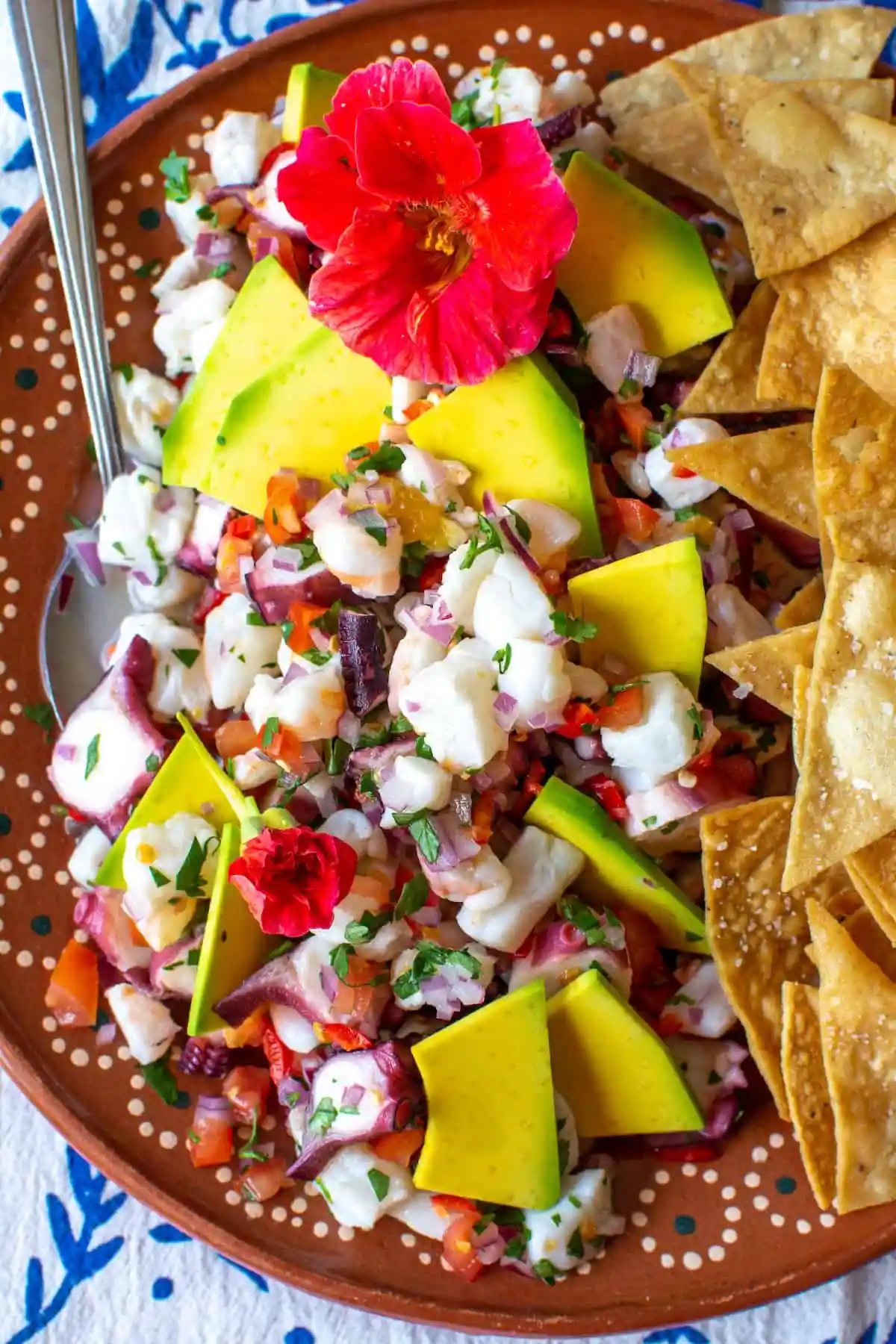Don’t be intimidated by artichokes! Although they look impenetrable they are actually very cook-friendly. In this post I’ll walk you through step-by-step on how to cook artichokes, how to eat them, and even a few artichoke recipes!
{This post was first published on April 14, 2010 and last updated on March 25, 2022}
Artichokes (alcachofa in Spanish) along with their cousins asparagus are the harbingers of spring and while asparagus is the easygoing child, artichokes can be malicious little beasts.

From the outside, they offer no enticement to be eaten—all prickly leaves and tough skin and the inside is even worse, no other vegetable has a part of it’s anatomy that is literally called a choke.
Artichokes fall into that category of food titled, “Who Thought It Would Be A Good Idea To Eat That?”
Well whoever had the tenacity to disarm this thorny thistle was onto something because artichokes have a natural earthy-brininess that cannot be found in any other vegetable. Let’s take a deep dive into how to cook and eat artichokes!
More To Explore
How To Cook Pork Chops
How To Make Homemade Chorizo
How To Doctor A Can of Beans
What Is An Artichoke?

An artichoke is actually the bud of a flower before it blooms. I am lucky enough to have an enormous artichoke plant (pictured above) and if I don’t harvest all the artichokes they turn into these gorgeous, gigantic flowers with purple spikes.
There are two main types of artichokes grown commercially: the Globe artichoke (also known as Green Globe) which is, as the name implies, round like a globe and a more elongated artichoke with a tapered end. The most common type of this variety is called the Imperial Star.
Artichokes are a Mediterranean vegetable so they grow best where there are mild winters. Like I mentioned, the plants get big—mine is four feet tall—but the artichoke itself can range in size from 4-8 inches in diameter.
The growing season here in Southern California is long (starting in late March through August) and they are perennial plants that can live many years.
How To Clean An Artichoke
Here’s how to get a fresh artichoke ready for cooking. These are the instructions for a full-grown artichoke, baby artichokes just need to have a few of the tough outer leaves removed and are ready to go.
step one
Slice off the top quarter of the artichoke with a serrated knife.

step two
Remove the tough outer leaves until you reach the more tender inner leaves that are lighter in color. Some people snip the pointy tops off the leaves with scissors but I usually don’t have any after I do all the trimming.

step three
Peel the tough skin off the stem with a pairing knife or vegetable peeler. Some people rub a lemon wedge over the artichoke after this step to prevent it from turning brown but I find it turns a darker color anyway after you cook it so I’m not sure that is necessary.

step four
I like to remove the fibrous choke after cooking if at all possible. It’s much easier that way. Cook as desired (see below) then cut in half with a serrated knife and slide a spoon where the fibers meet the artichoke heart. Scoop out the choke and discard.

How To Cook Artichokes
Now that your artichokes are cleaned let’s cook them! My two favorite ways to cook them whole are to steam them or roast them. But I’ve also included instructions for boiling them, which is another popular method. This is how to cook them for artichoke dipping.
Steaming artichokes

- To steam artichokes, fill a steamer pot with water. Cut a lemon in half and squeeze the halves into the water. I like to add some fresh herbs like a few sprigs of thyme, black peppercorns, and/or bay leaves.
- Set the steamer basket with the cleaned artichokes on top and cover tightly with a lid. Steam on medium until a knife is easily inserted in the base of the artichoke, about 40 minutes for a large one.
- If you don’t have a steamer pot you can also fill a large pot with the flavored water and set a trivet in the bottom with the artichokes on top of the trivet. Cover and cook.
Roasted artichokes

- To roast artichokes, heat oven to 425°F. Place cleaned artichokes in a baking dish in a single layer. Drizzle with olive oil, lemon juice, and season with salt and pepper. I usually put the squeezed lemon half in with the artichokes.
- Add about 1/2 inch of water to the dish then cover tightly with foil to keep all the steam in as they roast.
- Cook until a knife is easily inserted in the base of the artichoke, about 40-50 minutes for a large artichoke.
Boiled Artichokes

- Fill a large pot with water. Cut a lemon in half and squeeze the halves into the water, then add the squeezed lemons. Add a tablespoon or two of kosher salt (it should taste like sea water), a handful of herbs like thyme or bay leaves, a sliced onion, and a glug or two of white wine if you have it.
- Bring this water to a boil then reduce to a simmer. Add artichokes and weigh them down with a plate so they are submerged under the water.
- Simmer until a knife is easily inserted in the base of the artichoke, about 20 minutes for a large one.
- Remove to a large plate with tongs and let sit upside down to let the water drain out.
How To Eat Artichokes

Serve the globes whole with garlic butter, flavored mayo, or vinaigrette for dipping.
Just tear off a cooked leaf, dip, and scrape off the meaty leaf bottoms with your teeth. Once you get to the tender heart, remove the hairy choke, cut the heart into quarters and eat that and the stem too.
Some of my favorite dipping sauces are:
- Tajín compound butter
- White bean dip with garlic
- Green romesco sauce
- Roasted tomatillo and avocado hummus
Artichoke Recipes
Now we know how to cook artichokes, let’s us them in a few recipes!

- Make marinated artichokes by quartering the hearts and tender leaves and tossing with thinly sliced lemons, sprigs of herbs like thyme, salt, freshly ground black pepper, a pinch of red chile flakes, and sliced garlic. Pack into a container and cover with olive oil. Cover and refrigerate for at least 4 hours and up to 2 weeks.
- Spinach Artichoke Dip is always a favorite. I like this version, I just substitute the cooked artichokes for the marinated artichoke hearts in the recipe.
- Try for dinner this Chicken with Artichoke Ragu. It’s so delicious over pasta or creamy polenta.
- This chicken salad with artichokes, serrano ham, Greek yogurt, and chopped parsley is particularly nice.
More Spring Recipe Ideas
- Citrus Seafood Ceviche
- Mint and Sweet Pea Guacamole
- Brown Sugar Fruit Dip
- Grilled Asparagus Salad with Chunky Vinaigrette
- Mangonada {Spicy Mango Slushy}
- Strawberry Tamales with Horchata Sauce
- Authentic Tres Leches Cake
Ready To Show Those Artichokes Whose Boss?
Yeah you are! Let me know when you make them by snapping a pic and tagging me on Instagram @holajalapeno and #holajalapeno so I can see or leave me a comment below (don’t forget to leave a ⭐️⭐️⭐️⭐️⭐️ rating) ! Also, sign up for my weekly newsletter, lots of good stuff there too!

How to Cook Artichokes
The easiest way to clean and prepare fresh artichokes for eating.
Ingredients
- 4 Whole fresh artichokes
- 1-2 lemons (one for cooking and another for squeezing over the cooked artichokes)
- Fresh herbs like thyme, bay leaves, or tarragon
- Black peppercorns
- Kosher salt
- Olive oil
For Serving
- Garlic butter
- Flavored mayonnaise
- Green Romesco Sauce
Instructions
- Trim. Cut the top quarter of the artichoke off with a serrated knife.
- Peel. Next remove all the tough outer leaves until you get down to the tender light green or purple colored leaves. (Yes, you will remove about a third of the artichoke.) Slice about a 1/2-inch off the bottom of each stem and peel the tough skin off the stem and artichoke bottom. (I think this is easiest with a pairing knife.)
- To steam artichokes, fill a steamer pot with water. Cut a lemon in half and squeeze the halves into the water. I like to add some fresh herbs like a few sprigs of thyme, black peppercorns, and/or bay leaves.
- Set the steamer basket with the cleaned artichokes on top and cover tightly with a lid. Steam on medium until a knife is easily inserted in the base of the artichoke, about 40 minutes for a large one. If you don’t have a steamer pot you can also fill a large pot with the flavored water and set a trivet in the bottom with the artichokes on top of the trivet. Cover and cook.
- To roast artichokes, heat oven to 425°F. Place cleaned artichokes in a baking dish in a single layer. Drizzle with olive oil, lemon juice, and season with salt and pepper. I usually put the squeezed lemon half in with the artichokes.
- Add about 1/2 inch of water to the dish then cover tightly with foil to keep all the steam in as they roast.
- Cook until a knife is easily inserted in the base of the artichoke, about 40-50 minutes for a large artichoke. Squeeze a lemon over the cooked artichoke before serving.
- To eat, pluck the leaves from the cooked artichoke, dip the leaves in garlic butter, or flavored mayonnaise, and slide the ends between your teeth to collect the meaty bits.
Notes
To remove the choke before cooking:
- Cut the artichokes in half lengthwise. Which, I do with a chef's knife and I realize that I have now used 3 knives for this process, remember when I said they were malicious little beasts?
- Now scoop out the prickly little inner leaves and the choke with a small spoon and discard.
- Then cut however the recipe indicates and place in acidulated water. As you can tell from the photos, artichokes oxidize very quickly; some people rub them with lemon as they are cutting to prevent them from turning brown.
- Submerge them in the water using a small plate until you are ready to cook. Enjoy!
Recommended Products
As an Amazon Associate and member of other affiliate programs, I earn from qualifying purchases.
Nutrition Information:
Yield: 4 Serving Size: 1Amount Per Serving: Calories: 64Total Fat: 0gSaturated Fat: 0gTrans Fat: 0gUnsaturated Fat: 0gCholesterol: 0mgSodium: 72mgCarbohydrates: 14gFiber: 7gSugar: 1gProtein: 3g
In support of this small business, ¡Hola! Jalapeño earns revenue in a few different ways. Several sponsored posts are published each month. I also earn an affiliate commission on the sales of products I link to— there are a few of those links in this post. I only feature items I genuinely love and personally use on a regular basis. This commission is an arrangement between the retailer and ¡Hola! Jalapeño (readers never pay more for products). This income allows me to run the site. Thank you for reading!









leave a reply